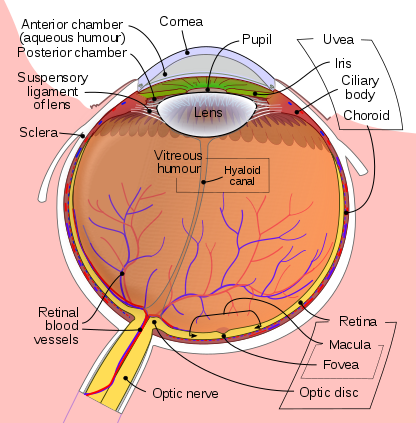[1]
Kawamura S, Tachibanaki S. Rod and cone photoreceptors: molecular basis of the difference in their physiology. Comparative biochemistry and physiology. Part A, Molecular & integrative physiology. 2008 Aug:150(4):369-77. doi: 10.1016/j.cbpa.2008.04.600. Epub 2008 Apr 26
[PubMed PMID: 18514002]
Level 2 (mid-level) evidence
[2]
Mendez A, Burns ME, Roca A, Lem J, Wu LW, Simon MI, Baylor DA, Chen J. Rapid and reproducible deactivation of rhodopsin requires multiple phosphorylation sites. Neuron. 2000 Oct:28(1):153-64
[PubMed PMID: 11086991]
[3]
Suppressing autophagy protects photoreceptor cells from light-induced injury., Zhang TZ,Fan B,Chen X,Wang WJ,Jiao YY,Su GF,Li GY,, Biochemical and biophysical research communications, 2014 Jul 25
[PubMed PMID: 24971547]
[4]
Lamb TD, Hunt DM. Evolution of the vertebrate phototransduction cascade activation steps. Developmental biology. 2017 Nov 1:431(1):77-92. doi: 10.1016/j.ydbio.2017.03.018. Epub 2017 Mar 25
[PubMed PMID: 28347645]
[5]
Astakhova L, Firsov M, Govardovskii V. Activation and quenching of the phototransduction cascade in retinal cones as inferred from electrophysiology and mathematical modeling. Molecular vision. 2015:21():244-63
[PubMed PMID: 25866462]
[6]
Chen CK. RGS Protein Regulation of Phototransduction. Progress in molecular biology and translational science. 2015:133():31-45. doi: 10.1016/bs.pmbts.2015.02.004. Epub 2015 Apr 16
[PubMed PMID: 26123301]
[7]
Autophagy supports survival and phototransduction protein levels in rod photoreceptors., Zhou Z,Doggett TA,Sene A,Apte RS,Ferguson TA,, Cell death and differentiation, 2015 Mar
[PubMed PMID: 25571975]
[8]
Emanuel AJ, Do MT. Melanopsin tristability for sustained and broadband phototransduction. Neuron. 2015 Mar 4:85(5):1043-55. doi: 10.1016/j.neuron.2015.02.011. Epub
[PubMed PMID: 25741728]
[9]
Schön C, Sothilingam V, Mühlfriedel R, Garcia Garrido M, Beck SC, Tanimoto N, Wissinger B, Paquet-Durand F, Biel M, Michalakis S, Seeliger MW. Gene Therapy Successfully Delays Degeneration in a Mouse Model of PDE6A-Linked Retinitis Pigmentosa (RP43). Human gene therapy. 2017 Dec:28(12):1180-1188. doi: 10.1089/hum.2017.156. Epub
[PubMed PMID: 29212391]
[10]
Occelli LM, Schön C, Seeliger MW, Biel M, Michalakis S, Petersen-Jones SM. Gene Supplementation Rescues Rod Function and Preserves Photoreceptor and Retinal Morphology in Dogs, Leading the Way Toward Treating Human PDE6A-Retinitis Pigmentosa. Human gene therapy. 2017 Dec:28(12):1189-1201. doi: 10.1089/hum.2017.155. Epub
[PubMed PMID: 29212382]
[11]
Eblimit A, Agrawal SA, Thomas K, Anastassov IA, Abulikemu T, Moayedi Y, Mardon G, Chen R. Conditional loss of Spata7 in photoreceptors causes progressive retinal degeneration in mice. Experimental eye research. 2018 Jan:166():120-130. doi: 10.1016/j.exer.2017.10.015. Epub 2017 Oct 31
[PubMed PMID: 29100828]
[12]
Wong WL, Su X, Li X, Cheung CM, Klein R, Cheng CY, Wong TY. Global prevalence of age-related macular degeneration and disease burden projection for 2020 and 2040: a systematic review and meta-analysis. The Lancet. Global health. 2014 Feb:2(2):e106-16. doi: 10.1016/S2214-109X(13)70145-1. Epub 2014 Jan 3
[PubMed PMID: 25104651]
Level 1 (high-level) evidence
[13]
Mehta S. Age-Related Macular Degeneration. Primary care. 2015 Sep:42(3):377-91. doi: 10.1016/j.pop.2015.05.009. Epub
[PubMed PMID: 26319344]
[14]
Gahlaut N, Suarez S, Uddin MI, Gordon AY, Evans SM, Jayagopal A. Nanoengineering of therapeutics for retinal vascular disease. European journal of pharmaceutics and biopharmaceutics : official journal of Arbeitsgemeinschaft fur Pharmazeutische Verfahrenstechnik e.V. 2015 Sep:95(Pt B):323-30. doi: 10.1016/j.ejpb.2015.05.001. Epub 2015 May 28
[PubMed PMID: 26022642]
[15]
Pershing S, Pal Chee C, Asch SM, Baker LC, Boothroyd D, Wagner TH, Bundorf MK. Treating age-related macular degeneration: comparing the use of two drugs among medicare and veterans affairs populations. Health affairs (Project Hope). 2015 Feb:34(2):229-38. doi: 10.1377/hlthaff.2014.1032. Epub
[PubMed PMID: 25646102]
[16]
Chiras D, Kitsos G, Petersen MB, Skalidakis I, Kroupis C. Oxidative stress in dry age-related macular degeneration and exfoliation syndrome. Critical reviews in clinical laboratory sciences. 2015 Feb:52(1):12-27. doi: 10.3109/10408363.2014.968703. Epub 2014 Oct 16
[PubMed PMID: 25319011]
[17]
van Lookeren Campagne M, LeCouter J, Yaspan BL, Ye W. Mechanisms of age-related macular degeneration and therapeutic opportunities. The Journal of pathology. 2014 Jan:232(2):151-64. doi: 10.1002/path.4266. Epub
[PubMed PMID: 24105633]
[18]
Zhang K, Zhang L, Weinreb RN. Ophthalmic drug discovery: novel targets and mechanisms for retinal diseases and glaucoma. Nature reviews. Drug discovery. 2012 Jun 15:11(7):541-59. doi: 10.1038/nrd3745. Epub 2012 Jun 15
[PubMed PMID: 22699774]
[19]
Jenkins AJ, Joglekar MV, Hardikar AA, Keech AC, O'Neal DN, Januszewski AS. Biomarkers in Diabetic Retinopathy. The review of diabetic studies : RDS. 2015 Spring-Summer:12(1-2):159-95. doi: 10.1900/RDS.2015.12.159. Epub 2015 Aug 10
[PubMed PMID: 26676667]
[20]
Sasongko MB, Wong TY, Jenkins AJ, Nguyen TT, Shaw JE, Wang JJ. Circulating markers of inflammation and endothelial function, and their relationship to diabetic retinopathy. Diabetic medicine : a journal of the British Diabetic Association. 2015 May:32(5):686-91. doi: 10.1111/dme.12640. Epub 2014 Dec 9
[PubMed PMID: 25407692]
[21]
Frank RN. Diabetic retinopathy and systemic factors. Middle East African journal of ophthalmology. 2015 Apr-Jun:22(2):151-6. doi: 10.4103/0974-9233.154388. Epub
[PubMed PMID: 25949071]
[22]
He Y, Zhang Y, Su G. Recent advances in treatment of retinitis pigmentosa. Current stem cell research & therapy. 2015:10(3):258-65
[PubMed PMID: 25345673]
Level 3 (low-level) evidence
[23]
He Y, Zhang Y, Liu X, Ghazaryan E, Li Y, Xie J, Su G. Recent advances of stem cell therapy for retinitis pigmentosa. International journal of molecular sciences. 2014 Aug 20:15(8):14456-74. doi: 10.3390/ijms150814456. Epub 2014 Aug 20
[PubMed PMID: 25141102]
Level 3 (low-level) evidence
[24]
Natarajan S. Decoding retinitis pigmentosa. Indian journal of ophthalmology. 2013 Mar:61(3):91-4. doi: 10.4103/0301-4738.109372. Epub
[PubMed PMID: 23514641]

